Effect of La on the Microstructures and Mechanical Properties of Al-5.4Cu-0.7Mg-0.6Ag Alloys
Abstract
:1. Introduction
2. Materials and Methods
3. Results
3.1. Microstructure of Alloys
3.2. SEM Observation
3.3. XRD Patterns
3.4. Tensile Properties

| Alloys | UTS()/MPa | YS()/MPa | El./% |
|---|---|---|---|
| La-free | 380.6 ± 8 | 341.3 ± 5 | 5.4 ± 0.6 |
| 0.2La | 387.0 ± 15 | 346.4 ± 4 | 7.4 ± 0.4 |
| 0.4La | 411.7 ± 8 | 386.0 ± 2 | 7.9 ± 0.5 |
| 0.6La | 405.7 ± 11 | 353.9 ± 4 | 5.1 ± 0.6 |
| Alloys | UTS()/MPa | YS()/MPa | El./% |
|---|---|---|---|
| La-free | 120.6 ± 4 | 103.5 ± 4 | 9.3 ± 0.4 |
| 0.2La | 131.6 ± 5 | 111.4 ± 3 | 7.6 ± 0.6 |
| 0.4La | 146.1 ± 4 | 128.3 ± 4 | 8.3 ± 0.5 |
| 0.6La | 129.1 ± 3 | 108.0 ± 3 | 11.3 ± 0.6 |
| Materials Composition (wt.%) | Temperature (°C) | UTS() (MPa) | References |
|---|---|---|---|
| Al-5.4Cu-0.7Mg-0.6Ag Al-12.95Si-3.57Cu-0.72Mg-0.91Ni-0.53Fe-0.4Er | 350 350 | 146.1 117 | Present work [20] |
| Al-12Si-3Cu-1.5Ni | 350 | ≈62 | [22] |
| Al-12Si-4Cu-2Ni-1Mg-AlNp | 350 | 106 | [23] |
| Al-6Cu-0.4Mn-0.4Ag | 350 | 135.8 | [24] |
| Al-11.79Si-3.33Cu-0.172Fe-2.05Mn-1Cr | 350 | 106 | [25] |
| A1-0.4Cu-8.2AlN | 350 | 119 | [26] |
| Al-12Si-0.9Cu-0.8Mg-4Ni | 350 | 116 | [26] |
| Al-12.5Si-0.84Mg-5Cu-2Ni-0.5Fe-(0.24~0.28) Cr | 350 | ≈92 | [27] |
| Al-12.87Si-5.45Cu-1.83Ni | 350 | 93.5 | [28] |
| Al-13Si-5Cu-0.6Fe-0.6Mn | 340 | 97 | [29] |
| Al-12.8Si-3.23Cu-1.01Mg-1Ni | 350 | 61.7 | [30] |
| Al-12.57Si-1.02Cu-1.23Mg-1.07Ni-0.15Mn | 350 | 75.6 | [31] |
3.5. High-Temperature Fracture
3.6. TEM Microstructures
4. Discussion
5. Conclusions
- (1)
- La can refine the grain of the Al-5.4Cu-0.7Mg-0.6Ag alloy, but the refining effect begins to weaken when the content of La is 0.6wt%.
- (2)
- At 350 °C, the tensile strength of the alloy increases with the increasing La content, and the elongation decreases first and then increases. The high-temperature tensile strength of the Al-5.4Cu-0.7Mg-0.6Ag alloy with added 0.4wt.% La at the T6 state is higher, which is 25.44MPa greater compared to the alloy without La.
- (3)
- The La element mainly exists in the form of the Al6Cu6La phase in the Al-5.4Cu-0.7Mg-0.6Ag alloy, which makes the excessive second phase in the grain boundary appear skeleton-like; at the same time, the size of the excessive phase is reduced, and the high-temperature plasticity of the alloy is improved.
- (4)
- In the La-added alloy, there exists an Al6Cu6La intermetallic compound distributed along the grain boundaries, which, after undergoing tensile deformation at 350 °C, breaks into fine particles, resulting in decreased mechanical properties.
- (5)
- The addition of La refines the size of the strengthening precipitate phase Ω and increases its precipitation density.
Author Contributions
Funding
Institutional Review Board Statement
Informed Consent Statement
Data Availability Statement
Conflicts of Interest
References
- Sepehrband, P.; Mahmudi, R.; Khomamizadeh, F. Effect of Zr Addition on the Aging Behavior of A319 Aluminum Cast Alloy. Scr. Mater. 2005, 52, 253–257. [Google Scholar] [CrossRef]
- Liu, G.; Zhang, G.; Wang, R.; Hu, W.; Sun, J.; Chen, K. Heat Treatment-Modulated Coupling Effect of Multi-Scale Second-Phase Particles on the Ductile Fracture of Aged Aluminum Alloys. Acta Mater. 2007, 55, 273–284. [Google Scholar] [CrossRef]
- Mostafa, M.M.; El-Sayed, M.M.; El-Sayed, H.A.; Abd-Elaleem, H. Steady State Creep During Transformation in Al–1 wt.%Cu Alloy. Mater. Sci. Eng. A 2009, 518, 97–99. [Google Scholar] [CrossRef]
- Yang, H.; Gao, T.; Zhang, H.; Nie, J.; Liu, X. Enhanced Age-Hardening Behavior in Al–Cu Alloys Induced by In-Situ Synthesized Tic Nanoparticles. J. Mater. Sci. Technol. 2018, 35, 374–382. [Google Scholar] [CrossRef]
- Xiao, D.H.; Song, M.; Chen, K.H.; Huang, B.Y. Effect of Rare Earth Yb Addition on Mechanical Properties of Al–5·3cu–0·8mg–0·6ag Alloy. Mater. Sci. Technol. 2007, 23, 1156–1160. [Google Scholar] [CrossRef]
- Srivastava, N.; Chaudhari, G.P.; Qian, M. Grain Refinement of Binary Al-Si, Al-Cu and Al-Ni Alloys by Ultrasonication. J. Mater. Process. Technol. 2017, 249, 367–378. [Google Scholar] [CrossRef]
- Kumar, R.; Villanova, J.; Lhuissier, P.; Salvo, L. In Situ Nanotomography Study of Creep Cavities in Al-3.6-Cu Alloy. Acta Mater. 2019, 166, 18–27. [Google Scholar] [CrossRef]
- Li, Q.; Zhang, Y.; Lan, Y.; Pei, R.; Feng, X.; Xia, T.; Liu, D. Effect of Scandium Addition on Microstructure and Mechanical Properties of as-Cast Al-5%Cu Alloys. Vacuum 2020, 177, 109385. [Google Scholar] [CrossRef]
- Li, G.; Zhang, X.; Zhu, H. Effects of Minor Er and Y Addi-Tion to Al-Zn-Mg-Cu-Zr Alloy on Microstructures and Mechanical Properties. J. Mater. Eng. 2010, 24, 78–82. [Google Scholar]
- van Dalen, M.E.; Gyger, T.; Dunand, D.C.; Seidman, D.N. Effects of Yb and Zr Microalloying Additions on the Microstructure and Mechanical Properties of Dilute Al–Sc Alloys. Acta Mater. 2011, 59, 7615–7626. [Google Scholar] [CrossRef]
- Chen, Z.; Chen, P.; Li, S. Effect of Ce Addition on Microstructure of Al20cu2mn3 Twin Phase in an Al–Cu–Mn Casting Alloy. Mater. Sci. Eng. A 2011, 532, 606–609. [Google Scholar] [CrossRef]
- Huang, X.; Yan, H. Effect of Trace La Addition on the Microstructure and Mechanical Property of as-Cast Adc12 Al-Alloy. J. Wuhan Univ. Technol. Mater. Sci. Ed. 2013, 28, 202–205. [Google Scholar] [CrossRef]
- Du, J.; Ding, D.; Xu, Z.; Zhang, J.; Zhang, W.; Gao, Y.; Chen, G.; Chen, W.; You, X.; Chen, R.; et al. Effect of Cela Addition on the Microstructures and Mechanical Properties of Al-Cu-Mn-Mg-Fe Alloy. Mater. Charact. 2017, 123, 42–50. [Google Scholar] [CrossRef]
- Du, J.; Ding, D.; Zhang, W.; Xu, Z.; Gao, Y.; Chen, G.; You, X.; Chen, R.; Huang, Y.; Tang, J. Effect of Ce Addition on the Microstructure and Properties of Al-Cu-Mn-Mg-Fe Lithium Battery Shell Alloy. Mater. Charact. 2018, 142, 252–260. [Google Scholar] [CrossRef]
- Wang, W.-T.; Zhang, X.-M.; Gao, Z.-G.; Jia, Y.-Z.; Ye, L.-Y.; Zheng, D.-W.; Liu, L. Influences of Ce Addition on the Microstructures and Mechanical Properties of 2519a Aluminum Alloy Plate. J. Alloys Compd. 2010, 491, 366–371. [Google Scholar] [CrossRef]
- Theska, F.; Yang, Y.; Sisco, K.D.; Plotkowski, A.; Primig, S. On the High-Temperature Stability of the Al8cu3ce Intermetallic in an Additively Manufactured Al-Cu-Ce-Zr Alloy. Mater. Charact. 2022, 191, 112109. [Google Scholar] [CrossRef]
- Chen, Z.; Chen, P.; Ma, C. Microstructures and Mechanical Properties of Al-Cu-Mn Alloy with La and Sm Addition. Rare Met. 2012, 31, 332–335. [Google Scholar] [CrossRef]
- Zhang, H.; Wu, M.; Li, Z.; Xiao, D.; Huang, Y.; Huang, L.; Liu, W. Effect of Combined Addition of Cela and Gdy on Microstructure and Mechanical Properties of as-Cast Al-Cu-Mn Alloys. Materials 2023, 16, 7332. [Google Scholar] [CrossRef]
- Shuai, L.; Zou, X.; Rao, Y.; Lu, X.; Yan, H. Synergistic Effects of La and Y on the Microstructure and Mechanical Properties of Cast Al-Si-Cu Alloys. Materials 2022, 20, 7283. [Google Scholar] [CrossRef]
- Chankitmunkong, S.; Eskin, D.G.; Patakham, U.; Limmaneevichitr, C. Microstructure and Elevated Temperature Mechanical Properties of a Direct-Chill Cast Aa4032 Alloy with Copper and Erbium Additions. J. Alloys Compd. 2019, 782, 865–874. [Google Scholar] [CrossRef]
- Song, Z.-X.; Li, Y.-D.; Liu, W.-J.; Yang, H.-K.; Cao, Y.-J.; Bi, G.-L. Effect of La and Sc Co-Addition on the Mechanical Properties and Thermal Conductivity of as-Cast Al-4.8% Cu Alloys. Metals 2021, 11, 1866. [Google Scholar] [CrossRef]
- Zuo, L.; Ye, B.; Feng, J.; Xu, X.; Kong, X.; Jiang, H. Effect of Δ-Al3cuni Phase and Thermal Exposure on Microstructure and Mechanical Properties of Al-Si-Cu-Ni Alloys. J. Alloys Compd. 2019, 791, 1015–1024. [Google Scholar] [CrossRef]
- Hu, K.; Xu, Q.; Ma, X.; Sun, Q.; Gao, T.; Liu, X. A Novel Heat-Resistant Al–Si–Cu–Ni–Mg Base Material Synergistically Strengthened by Ni-Rich Intermetallics and Nano-Alnp Microskeletons. J. Mater. Sci. Technol. 2018, 35, 306–312. [Google Scholar] [CrossRef]
- Xiangzhou, F.; Hailong, Y.; Hanzhang, W.; Chifu, H.; Yongbin, C.; Qiangang, H.; Anmin, L.; Liwen, P. Effect of Mn/Ag Ratio on Microstructure and Mechanical Properties of Heat-Resistant Al-Cu Alloys. Materials 2024, 17, 1371. [Google Scholar] [CrossRef]
- Li, G.; Liao, H.; Suo, X.; Tang, Y.; Dixit, U.S.; Petrov, P. Cr-Induced Morphology Change of Primary Mn-Rich Phase in Al-Si-Cu-Mn Heat Resistant Aluminum Alloys and Its Contribution to High Temperature Strength. Mater. Sci. Eng. A 2017, 709, 90–96. [Google Scholar] [CrossRef]
- Ma, X.; Zhao, Y.; Zhao, X.; Gao, T.; Chen, H.; Liu, X. Influence Mechanisms of Cu or Fe on the Microstructures and Tensile Properties at 350 °C of Network Alnp Reinforced Al Composites. J. Alloys Compd. 2018, 740, 452–460. [Google Scholar] [CrossRef]
- Yang, Y.; Zhong, S.-Y.; Chen, Z.; Wang, M.; Ma, N.; Wang, H. Effect of Cr Content and Heat-Treatment on the High Temperature Strength of Eutectic Al–Si Alloys. J. Alloys Compd. 2015, 647, 63–69. [Google Scholar] [CrossRef]
- Yang, Y.; Yu, K.; Li, Y.; Zhao, D.; Liu, X. Evolution of Nickel-Rich Phases in Al–Si–Cu–Ni–Mg Piston Alloys with Different Cu Additions. Mater. Des. 2012, 33, 220–225. [Google Scholar] [CrossRef]
- Wang, E.R.; Hui, X.D.; Chen, G.L. Eutectic Al–Si–Cu–Fe–Mn Alloys with Enhanced Mechanical Properties at Room and Elevated Temperature. Mater. Des. 2011, 32, 4333–4340. [Google Scholar] [CrossRef]
- Li, Y.; Yang, Y.; Wu, Y.; Wang, L.; Liu, X. Quantitative Comparison of Three Ni-Containing Phases to the Elevated-Temperature Properties of Al–Si Piston Alloys. Mater. Sci. Eng. A 2010, 527, 7132–7137. [Google Scholar] [CrossRef]
- Qian, Z.; Liu, X.; Zhao, D.; Zhang, G. Effects of Trace Mn Addition on the Elevated Temperature Tensile Strength and Microstructure of a Low-Iron Al–Si Piston Alloy. Mater. Lett. 2008, 62, 2146–2149. [Google Scholar] [CrossRef]
- Liu, T.; Dong, Q.; Fu, Y.; Yang, J.; Zhang, J.; Sun, B. Effect of Addition of La and Ce on Solidification Behavior of Al-Cu Alloys. Mater. Lett. 2022, 324, 132653. [Google Scholar] [CrossRef]
- Di, W. Effect of Lanthanum on Microstructure and Properties of Casting Al-Cu-Mn-Ti-Cd-Zr Alloy. Hot Work. Technol. 2013, 42, 90–92. [Google Scholar]
- Elgallad, E.; Samuel, F.; Samuel, A.; Doty, H. Development of New Al-Cu Based Alloys Aimed at Improving the Machinability of Automotive Castings. Int. J. Met. 2015, 3, 29–41. [Google Scholar] [CrossRef]
- Mei, Z.Q.; Liu, Z.Y.; Bai, S.; Wang, J.; Cao, J. Effects of Yttrium Additions on Microstructures and Mechanical Properties of Cast Al-Cu-Mg-Ag Alloys. J. Alloys Compd. 2021, 870, 159435. [Google Scholar] [CrossRef]
- Li, Y.T.; Liu, Z.Y.; Liu, Y.B. Alloying Behavior of Rare-Earth Er in Al-Cu-Mg-Ag Alloy. Mater. Sci. Forum 2007, 546, 941–946. [Google Scholar]
- Zhu, A.W.; Starke, E.A. Strengthening Effect of Unshearable Particles of Finite Size: A Computer Experimental Study. Acta Mater. 1999, 47, 3263–3269. [Google Scholar] [CrossRef]
- Kurmanaeva, L.; Topping, T.D.; Wen, H.; Sugahara, H.; Yang, H.; Zhang, D.; Schoenung, J.M.; Lavernia, E.J. Strengthening Mechanisms and Deformation Behavior of Cryomilled Al–Cu–Mg–Ag Alloy. J. Alloys Compd. 2015, 632, 591–603. [Google Scholar] [CrossRef]
- Malopheyev, S.; Kulitskiy, V.; Kaibyshev, R. Deformation Structures and Strengthening Mechanisms in an Almgsczr Alloy. J. Alloys Compd. 2017, 698, 957–966. [Google Scholar] [CrossRef]
- Ma, K.; Wen, H.; Hu, T.; Topping, T.D.; Isheim, D.; Seidman, D.N.; Lavernia, E.J.; Julie, M. Schoenung. Mechanical Behavior and Strengthening Mechanisms in Ultrafine Grain Precipitation-Strengthened Aluminum Alloy. Acta Mater. 2014, 62, 141–155. [Google Scholar] [CrossRef]
- Shanmugasundaram, T.; Heilmaier, M.; Murty, B.S.; Sarma, V.S. On the Hall–Petch Relationship in a Nanostructured Al–Cu Alloy. Mater. Sci. Eng. A 2010, 527, 7821–7825. [Google Scholar] [CrossRef]
- Bahl, S.; Hu, X.; Hoar, E.; Cheng, J.; Haynes, J.A.; Shyam, A. Effect of Copper Content on the Tensile Elongation of Al–Cu–Mn–Zr Alloys: Experiments and Finite Element Simulations. Mater. Sci. Eng. A 2019, 772, 138801. [Google Scholar] [CrossRef]
- Li, Z.M.; Wang, H.; Wei. Grain Refinement and Modification of Al-Cu Alloys with Yttrium. J. Wuhan Univ. Technol. 2009, 21, 54–58. Available online: https://kns.cnki.net/kcms2/article/abstract?v=5iIAKlsf9WAWxShi7ZNhanSpvnL-nk2hrn3Kp_XWQ45SUUOykhhxwCIr0RfjmC-qWQ7l-WpxCO_fVd4C7yaPUjufFiUTrZPOpr0Dn5MpMJvkUqOGfKX7xnAOiSdWwS_B-TAZYkbxbLxcbytDJ9VAcVMVgjonIFijVxbTlG-A2T0aFhQCKv7VYwKMNjngc1n0wXYhWpZZLFxd8nb84_ogGw==&uniplatform=NZKPT&language=CHS (accessed on 13 July 2024).
- Zhang, F.; Guo, T.-B.; Li, Q.; Wang, C.; Ding, W.-W.; Li, Q.-L. Effects of Minor Y, Zr and Er Addition on Microstructure and Properties of Al-5cu-0.4 mn Alloy. China Foundry 2017, 14, 461–468. [Google Scholar] [CrossRef]
- Bahl, S.; Hu, X.; Sisco, K.; Haynes, J.A.; Shyam, A. Influence of Copper Content on the High Temperature Tensile and Low Cycle Fatigue Behavior of Cast Al-Cu-Mn-Zr Alloys. Int. J. Fatigue 2020, 140, 105836. [Google Scholar] [CrossRef]
- Buban, J.P.; Matsunaga, K.; Chen, J.; Shibata, N.; Ching, W.Y.; Yamamoto, T.; Ikuhara, Y. Grain Boundary Strengthening in Alumina by Rare Earth Impurities. Science 2006, 311, 212–215. [Google Scholar] [CrossRef]
- Pai, B.C.; Pillai, U.T.S.; Manikandan, P.; Srinivasan, A. Modification of Az91 mg Alloys for High Temperature Applications. Trans. Indian Inst. Met. 2012, 65, 601–606. [Google Scholar] [CrossRef]
- Hirosawa, S.; Sato, T.; Kamio, A.; Flower, H.M. Classification of the Role of Microalloying Elements in Phase Decomposition of Al Based Alloys. Acta Mater. 2000, 48, 1797–1806. [Google Scholar] [CrossRef]
- Bai, S.; Liu, Z.; Li, Y.; Hou, Y.; Chen, X. Microstructures and Fatigue Fracture Behavior of an Al–Cu–Mg–Ag Alloy with Addition of Rare Earth Er. Mater. Sci. Eng. A 2010, 527, 1806–1814. [Google Scholar] [CrossRef]
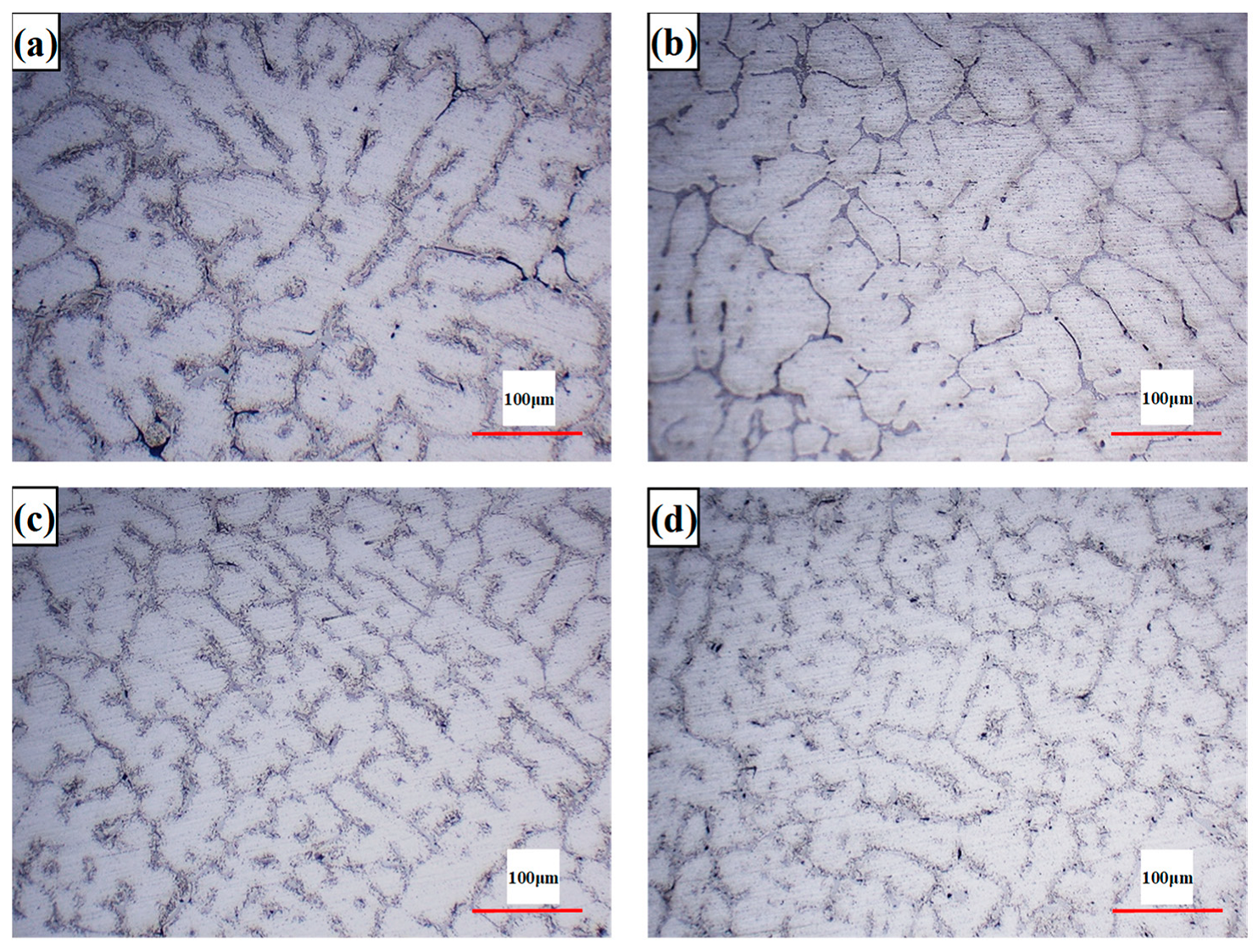

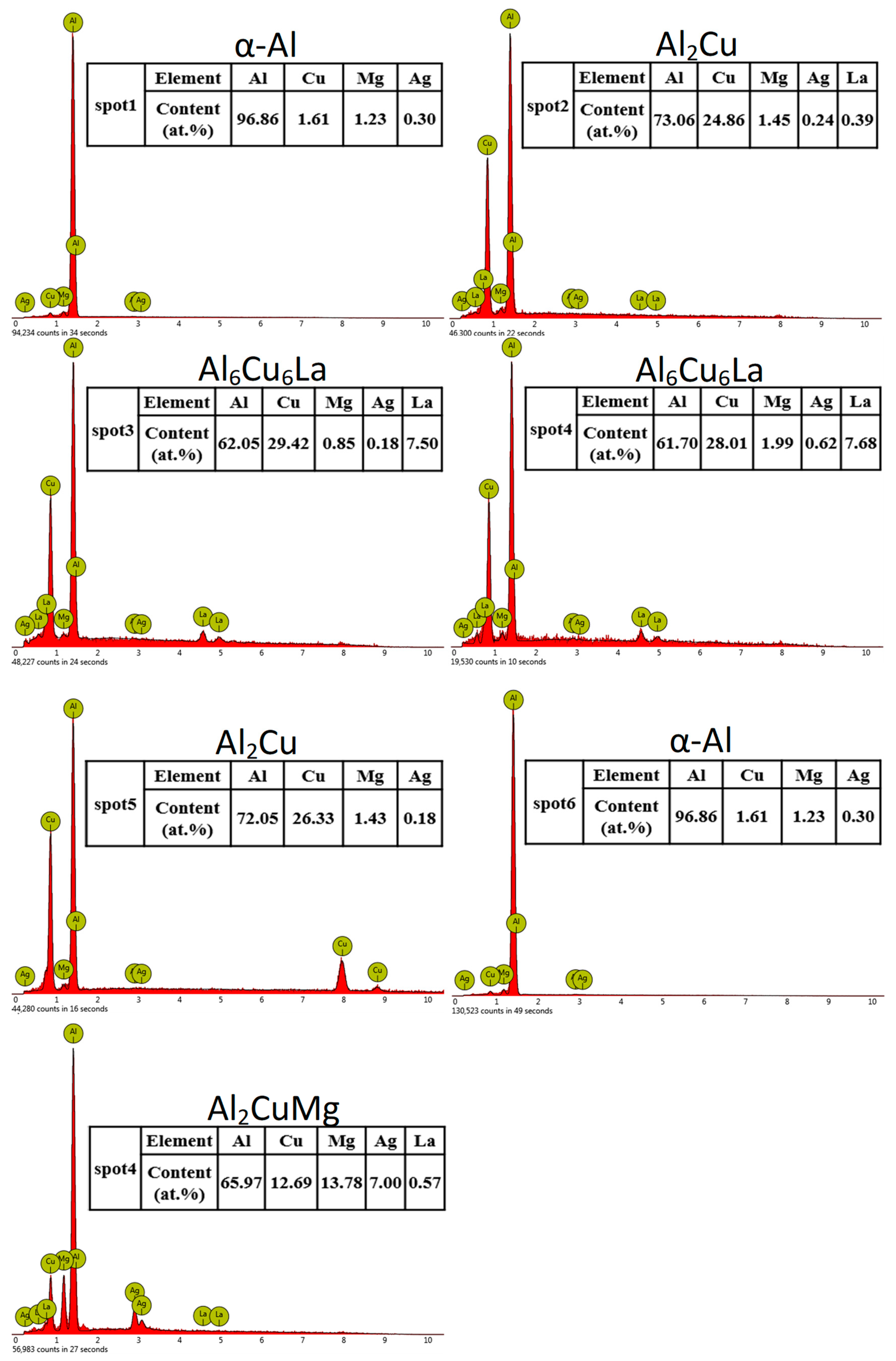
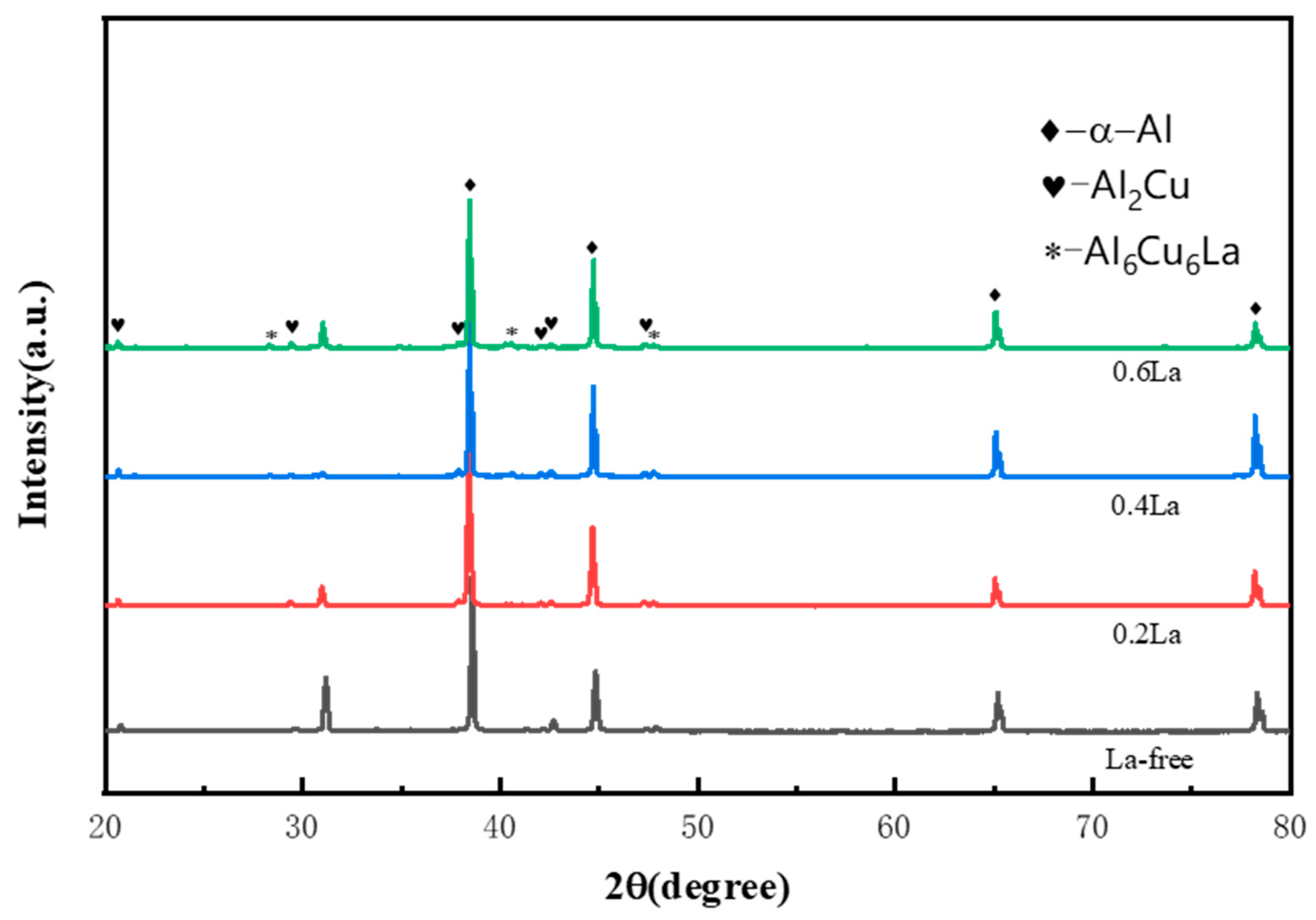

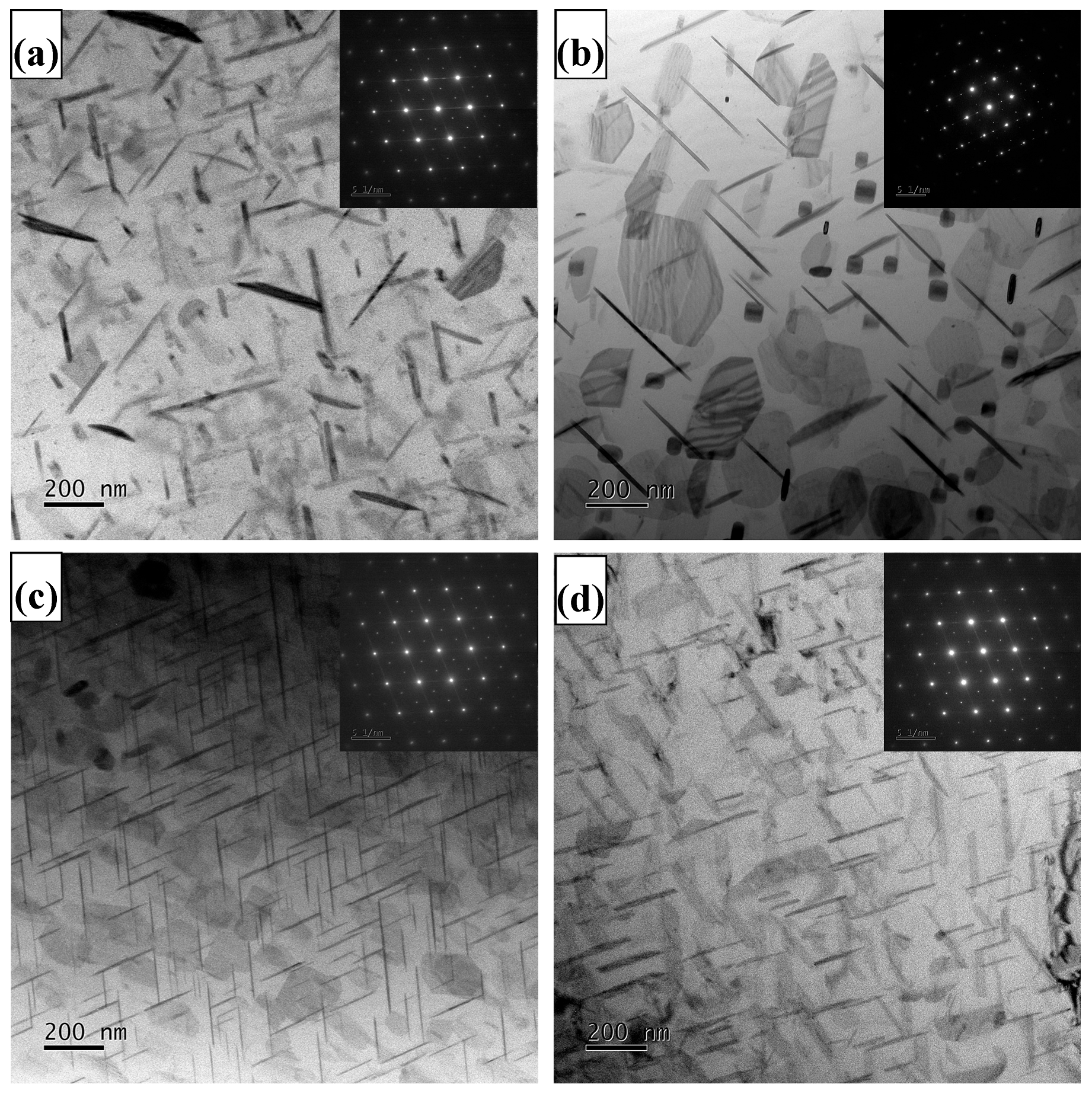
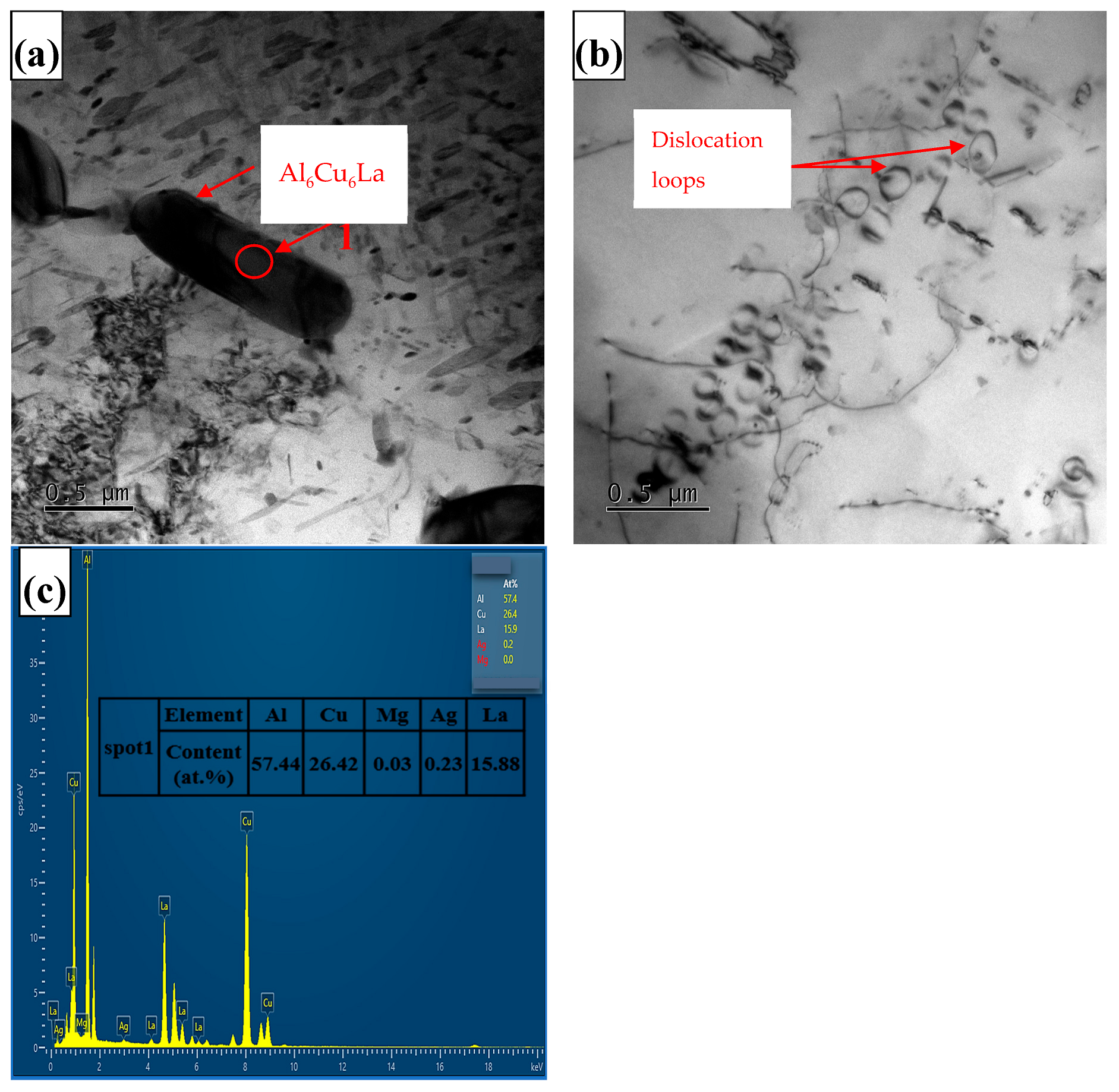
| Alloy | Cu | Mg | Ag | La | Al |
|---|---|---|---|---|---|
| La-free | 5.4 | 0.7 | 0.6 | 0 | Bal. |
| 2La | 5.4 | 0.7 | 0.6 | 0.2 | Bal. |
| 4La | 5.4 | 0.7 | 0.6 | 0.4 | Bal. |
| 6La | 5.4 | 0.7 | 0.6 | 0.6 | Bal. |
| Alloy | Cu | Mg | Ag | La | Al |
|---|---|---|---|---|---|
| La-free | 5.35 | 0.61 | 0.58 | 0 | Bal. |
| 2La | 5.37 | 0.68 | 0.58 | 0.17 | Bal. |
| 4La | 5.44 | 0.73 | 0.56 | 0.36 | Bal. |
| 6La | 5.41 | 0.69 | 0.54 | 0.59 | Bal. |
| Spot | Al | Cu | Mg | Ag | La | Phase Type |
|---|---|---|---|---|---|---|
| 1 | 96.86 | 1.61 | 1.23 | 0.30 | 0 | α-Al |
| 2 | 73.06 | 24.86 | 1.45 | 0.24 | 0.39 | Al2Cu |
| 3 | 62.05 | 29.42 | 0.85 | 0.18 | 7.50 | Al6Cu6La |
| 4 | 61.70 | 28.01 | 1.99 | 0.62 | 7.68 | Al6Cu6La |
| 5 | 72.05 | 26.33 | 1.43 | 0.18 | 0 | Al2Cu |
| 6 | 96.86 | 1.61 | 1.23 | 0.30 | 0 | α-Al |
| 7 | 65.97 | 12.69 | 13.78 | 7.00 | 0.57 | Al2CuMg |
| Alloy Element | Al | Cu | Mg | La |
|---|---|---|---|---|
| Atomic radius (nm) | 0.413 | 0.128 | 0.160 | 0.187 |
| Electronegativity | 1.610 | 1.900 | 1.310 | 0.110 |
| Alloys | Average Plate Diameter (nm) | Average Plate Thickness (nm) | Number Density (m−3) | Volume Fraction (%) |
|---|---|---|---|---|
| La-free | 189.27 | 16.85 | 4.61 | |
| 0.2La | 221.07 | 16.70 | 8.01 | |
| 0.4La | 163.92 | 8.06 | 11.86 | |
| 0.6La | 152.31 | 17.66 | 9.51 |
Disclaimer/Publisher’s Note: The statements, opinions and data contained in all publications are solely those of the individual author(s) and contributor(s) and not of MDPI and/or the editor(s). MDPI and/or the editor(s) disclaim responsibility for any injury to people or property resulting from any ideas, methods, instructions or products referred to in the content. |
© 2024 by the authors. Licensee MDPI, Basel, Switzerland. This article is an open access article distributed under the terms and conditions of the Creative Commons Attribution (CC BY) license (https://creativecommons.org/licenses/by/4.0/).
Share and Cite
Li, X.; Li, A.; Qin, X.; Yang, H.; Cheng, P. Effect of La on the Microstructures and Mechanical Properties of Al-5.4Cu-0.7Mg-0.6Ag Alloys. Materials 2024, 17, 4141. https://doi.org/10.3390/ma17164141
Li X, Li A, Qin X, Yang H, Cheng P. Effect of La on the Microstructures and Mechanical Properties of Al-5.4Cu-0.7Mg-0.6Ag Alloys. Materials. 2024; 17(16):4141. https://doi.org/10.3390/ma17164141
Chicago/Turabian StyleLi, Xiang, Anmin Li, Xiangdu Qin, Hailong Yang, and Peng Cheng. 2024. "Effect of La on the Microstructures and Mechanical Properties of Al-5.4Cu-0.7Mg-0.6Ag Alloys" Materials 17, no. 16: 4141. https://doi.org/10.3390/ma17164141




